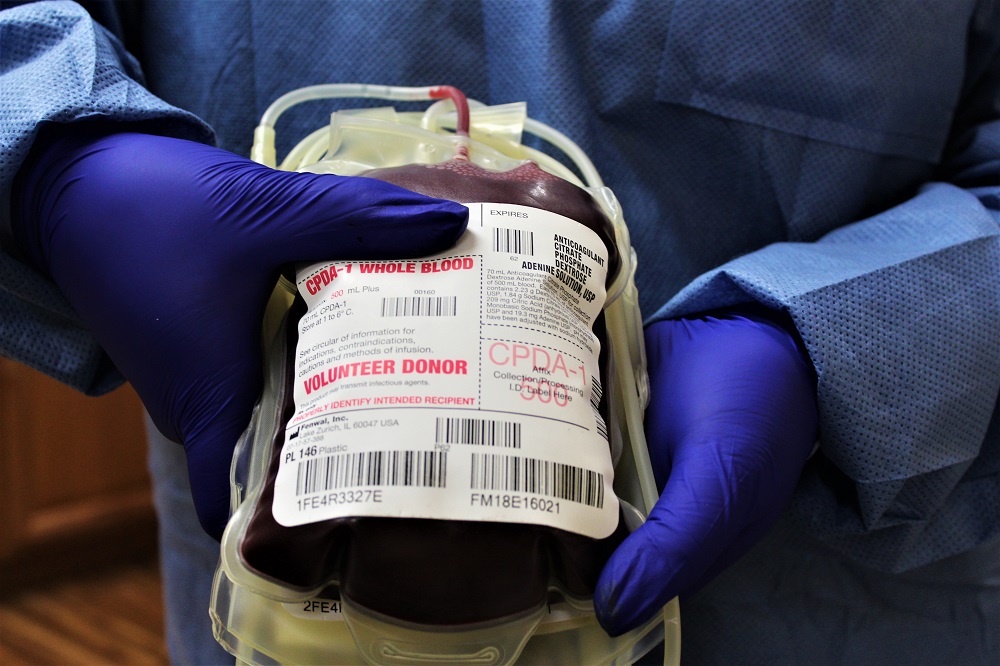
(Adelyn Baxter / KTOO)
Alaska’s sole blood bank is holding its first blood drive in Wrangell in more than a decade – and might be its first blood drive on the Southeast island ever. Coordinators say it’s a unique opportunity for Wrangell teens and adults to help save lives, and to engage in some friendly competition with neighboring Petersburg.
Once each morning and afternoon, Alaska Airlines flies north and south through Southeast Alaska on a route nicknamed the “Milk Run.” The flight was named for its unique style of takeoff and landing, delivering and picking up perishables at communities throughout the region.
Soon, a new perishable will be making its way up the inside passage from Wrangell – blood.
“Blood has a shelf life like milk,” explains Westley Dahlgren, director of collections and recruitment for the Blood Bank of Alaska. “It’s really weird to say, but yeah, blood has a shelf life of 42 days.”
The nonprofit is based in Anchorage and is the only blood bank in the state. Dahlgren says there are a number of reasons Blood Bank of Alaska hasn’t held a drive in Wrangell. It’s tough to ship supplies and staff down on flights or ferries, but also a logistical trouble to get donated blood out of transport boxes and processed in a proper amount of time.
“I don’t know very many blood centers around the United States that are actually going to send people by plane with equipment as far away from our headquarters in Anchorage, [as it is] to Wrangell,” Dahlgren says, adding: “I mean, in most states, that [distance is] a whole nother state.”
COVID put a kibosh on mobile blood drives, especially in rural communities like Wrangell. But SiQuita Marshall, the community coordinator for the Blood Bank of Alaska, says drives in Wrangell and nearby Petersburg have been in the works for years. And so has the idea of a friendly competition – to see which community donates the most blood.
“Last year, after the pandemic had settled down a little bit, vaccination was available, we were able to go out to Petersburg and kick the competition off,” Marshall says, “So they’ve had their first round, two days getting collections. And now it’s Wrangell’s turn.”
For now, Marshall keeps mum about how much blood the community of Petersburg donated last August.
“It’s kind of a secret, because we want to do the best without giving away too much. It’s like a blind collection,” Marshall says, “So I know how many Petersburg collected. So now, Wrangell is gonna go, and then at the end of Wrangell’s drive, I’ll let both hospitals know which city came through the most.”
Dahlgren says the process of donating blood is fairly straightforward. Potential donors schedule an appointment, and answer a health questionnaire about recent travel, medications, and potential risk factors. There’s a health screening looking at blood pressure, pulse, and the number of red blood cells in an individual’s blood.
“The actual blood draw process is probably the shortest part of the whole thing,” Dahlgren says. “Generally, it’s about five to 10 minutes.”
In total, the blood bank will take a pint of blood from each donor – about 2 cups. It’s one-tenth of a person’s total blood supply, which the body replaces over the next few weeks.
From there, Dahlgren explains: “We can break it down into multiple blood products. Not only the red cells, but the plasma, and then we make a product called cryo, which is a clotting factor that’s used in hospitals and whatnot. So potentially somebody who donates could theoretically save three lives.”
Anyone over the age of 16 can donate blood, although 16- and 17-year-olds have to have parental consent.
“All blood types are needed, right? Because all blood types are special and unique,” Dahlgren says. “Even something like [blood type] B- is about 1% of the population. So getting people to come in and donate B- is important, so there’s a safe, stable supply on the shelf. O+ and O- are unique in the sense that O- is a universal donor so it can be transfused to anybody. So in the event of a trauma, before they have typed the person’s blood type they’ll use O-. And O+ is always needed because it can be transfused to 87% of the population.”
Only about 2% of Alaska’s population donates blood, lower than the national average. Dahlgren says some of that could be due to a lack of opportunity, especially in rural communities like Wrangell.
“In the 13 years I’ve been here we haven’t gone to Wrangell to do a blood drive,” Dahlgren says, “So the availability for people who live in Wrangell to donate is pretty limited.”
Last summer, while the pandemic was still keeping people home, there was an uptick in elective surgeries and trauma cases nationwide, which caused a critical blood shortage.
“I’d never seen anything like it,” Dahlgren says. And that shortage was a lot scarier than people might realize – at times, the Blood Bank of Alaska was down to less than a day’s supply of some types of blood. And while it’s not at critical supply levels any more, he says it’s always more of a wire to walk than he’d like.
“I would love to have a robust supply of blood on the shelf where I never have to worry about inventory levels and things like that,” he adds, “But it’s a catch-22 because if you have too much blood on the shelf… you don’t want to waste it.”
Dahlgren says that blood collected at drives around the state stays in the state: “Our number one priority is to Alaskans and our partner hospitals throughout the state of Alaska.”
Because of blood’s short shelf life, he says donations are initially sent out to more rural, outlying communities throughout the state, then are rotated to places with larger population bases like Anchorage or Fairbanks, where it has a higher probability of being utilized.
“The only time we would ship blood out of state would be, again, the shelf life of blood, if blood is going to expire on their shelves, we would much rather have that go out of state to be used to save a life on a state than to just expire on ourselves shelves,” Dahlgren explains. “We don’t want to waste the gift of life that our donors gave us.”
Dahlgren says there’s a “huge” amount of uncertainty when planning a blood drive in a place the bank hasn’t been before.
“You don’t know how things are gonna happen. You don’t know how many donors are gonna show up, you don’t know if the community is gonna be receptive,” Dahlgren says. But he’s optimistic: “My guess is the community is going to be receptive, and it’s going to be a great blood drive, and people are going to be very happy we’re there.”
Plus, community coordinator Marshall adds, Wrangellites have another chance to duke it out with Petersburg – but in a potentially life-changing way.
“Petersburg seems super competitive and they want to win,” Marshall says with a laugh. “But anything we collect is saving a life. With every donation of whole blood, potentially three lives are saved, so that’s the big factor, regardless of who wins, or if there is a winner per se, we’re still saving lives.”
And saving lives, they say, is the most important part of the whole process.
Wrangell’s blood drive will take place in the Evergreen Elementary School gym from 10 a.m. to 6 p.m. Sunday, July 24 and Monday, July 25. Sign up for an appointment at BloodBankOfAlaska.org. Donors are asked to hydrate and eat a snack beforehand, and to bring a photo I.D.
Get in touch with KSTK at news@kstk.org or (907) 874-2345.












